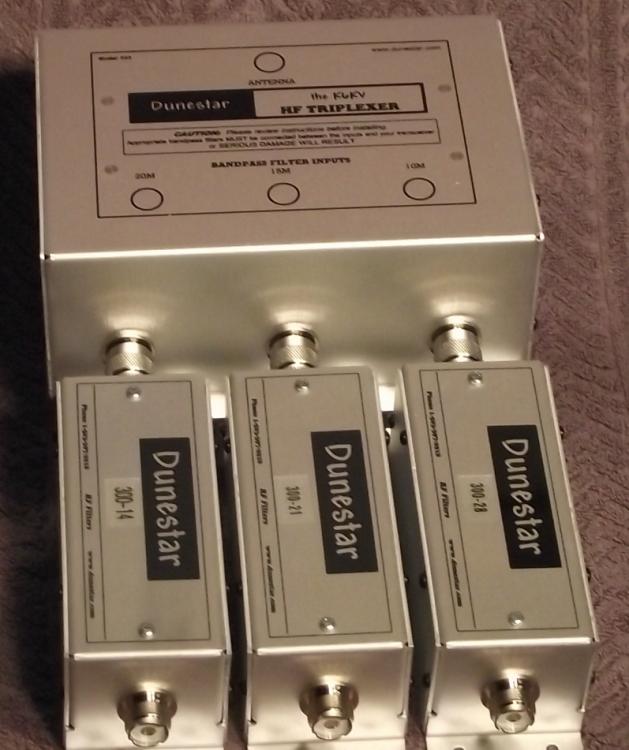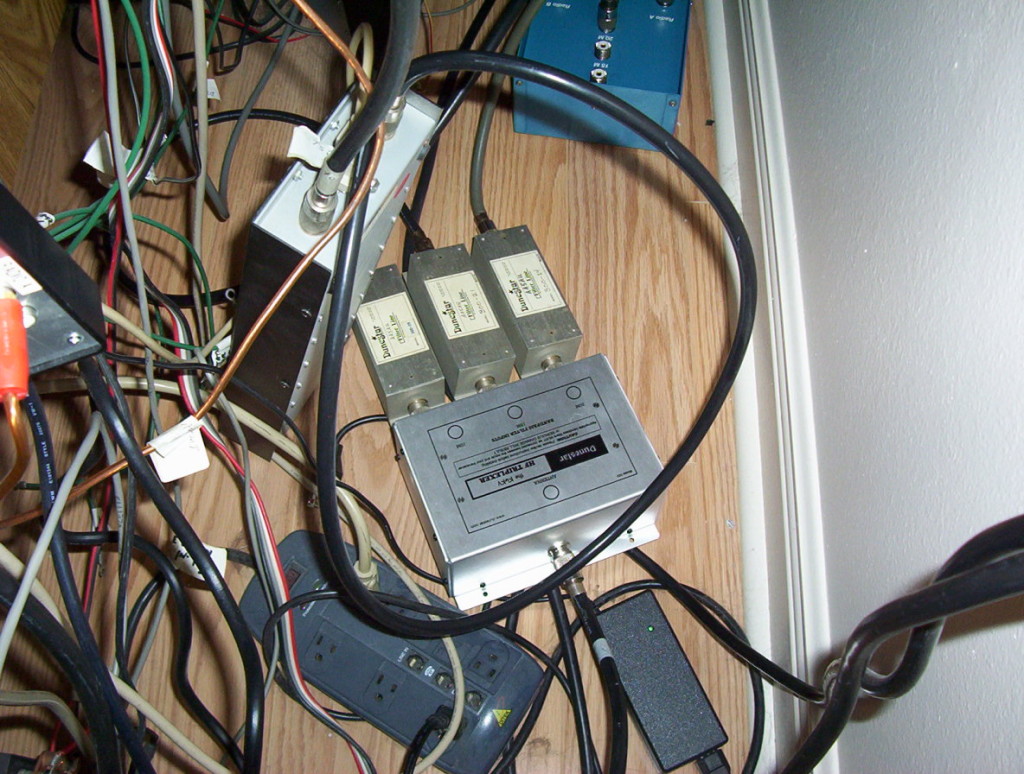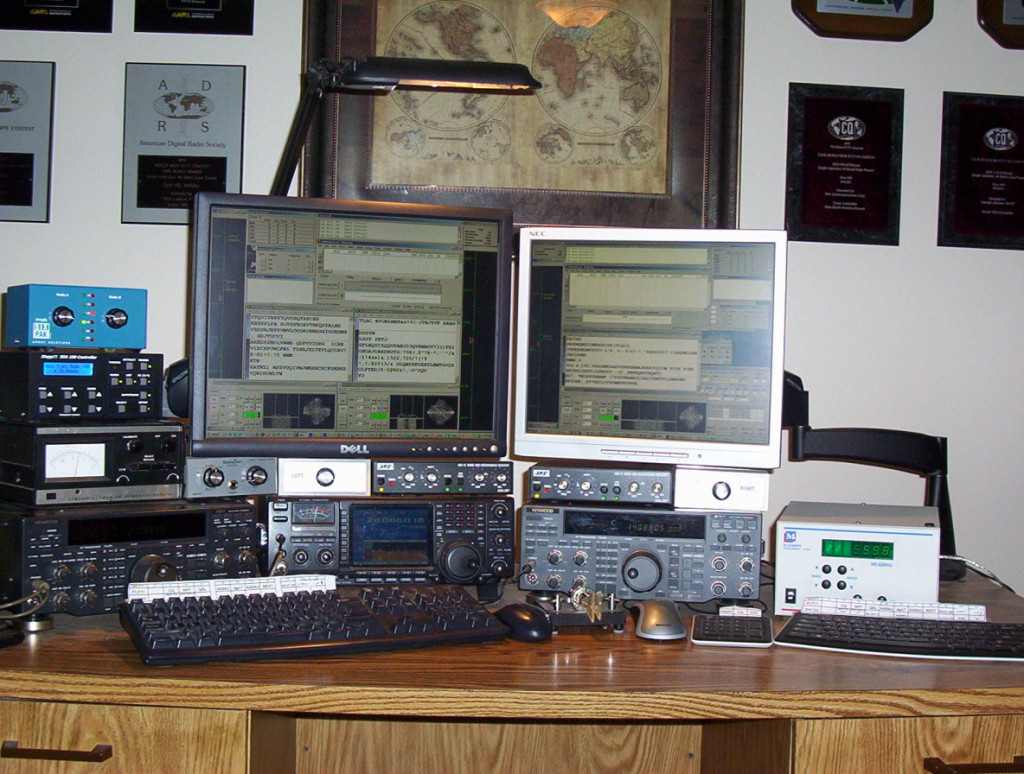2012 ARRL RTTY Roundup – SO3R Setup
Preparation for the 2012 ARRL RTTY Roundup started in September 2011 when I tried, unsuccessfully, to integrate a third radio into my station for the CQWW RTTY Contest. The only suitable third radio I had was a “spare” Kenwood TS-870. It’s actually the first TS-870 I ever purchased some 20 years or so ago. I hadn’t used this radio much because the display is not as bright as my newer TS-870. So I relegated it as a spare. My normal SO2R setup is an Icom IC-756 PRO III and my “newer” TS-870. For the 2011 CQWW RTTY contest, I set up for SO3R using the only three HF antennas I had installed at the time which was a 3-element SteppIR with the 30/40 loop dipole add-on, a KT-34M2, which I converted from a KT36M2 in early 2011, and an 80 meter inverted vee hanging off the higher of my two Rohn 25 towers. It wasn’t the best setup but I wanted to give it a try. Two hours before the CQWW RTTY contest started, the older TS-870 stopped receiving. Actually it received, but all noise. Same thing on transmit. I would transmit FSK but it was transmitting only noise. So I didn’t get to go SO3R in CQWW but I still managed my best score ever in that contest. I was going to send the radio in for repair but I checked the radio after that contest, and it worked. And it worked for the next three months.
In November 2011, I was exchanging email with Mark, N2QT, on various subjects and he mentioned he was building an HF triplexer. I had never heard of such a thing, so I searched the Internet to find that both Dunestar Systems and INRAD had just started marketing HF triplexers. As the gears churned in my head, I envisioned how this triplexer might just be the thing for my SO3R setup. I was very interested in learning more about the HF triplexer so I emailed Ron at Dunestar inquiring his HF triplexer. I use a lot of Dunestar products in my station and Ron has always been great to work with on any issues I’d ever had with his products. I own two Dunestar 600 all-band filters and individual Dunestar 300 band filters for 10, 15, 20, 40 and 80 meters. I also use a Dunestar 2-radio headphone selector. Ron promptly answered my email and told me everything I needed to know about his triplexer, and as an added bonus, he offered to send me one to test. I eagerly agreed and in a few days received the triplexer in the mail.
The first thing I had to figure out was how to integrate the triplexer into the station. I spent quite a few hours thinking about this and even threw some of my ideas back to Ron to see if they were possible. Since HF triplexers are designed to be used on triband antennas, then I would have to use it on my KT34 tribander. But how? The best solution I came up with, and the one I decided on, was to connect the KT-34 directly to the antenna port on the triplexer. I would then connect the 10, 15 and 20 meter radio ports of the triplexer directly to 10, 15 and 20 meter single-band Dunestar bandpass filter which I already had. Ron had included three male-to-male UHF adapters in with the triplexer, so I was able to direct-connect the filters to the triplexer exactly as he shows on the Dunestar website and shown below (courtesy of Dunestar Systems).
Here’s what mine actually looked like.
The other end of the bandpass filters would then connect directly to the 10, 15 and 20 meter antenna ports of my SixPak 2-radio antenna switch (partially shown as the blue box at the top of above photo). My plan was to allow two Kenwood TS-870 transceivers to share the KT-34 tribander through the triplexer by connected the two radios to the A and B inputs of the SixPak. My Icom IC-756 PRO III would be dedicated to the 3 element SteppIR since the Icom is my main shack radio and already controls the SteppIR automatically through radio control. The only problem I really had was that the KT34 has 3:1 SWR on 10 meters and I know from experience the antenna does not work on ten. So I really didn’t need to connect the 10 meter port on the triplexer to the SixPak but I did it anyway in case I wanted to hunt for multipliers on ten while the other two radios were on other bands. In this configuration, the Kenwoods could be on 15 and 20 meters while the Icom was operating on 10 meters. Or, the other two radios (Icom and one of the Kenwoods) could be on any other bands and I could spy on 10 meters with one of the Kenwoods. This was a great setup and it worked well during 8 days of pre-contest testing. The only other thing I had to do was connect my 80 meter inverted vee to the SixPak (through a Dunestar 80M bandpass filter) and now I am able to use either Kenwood on 80 meters as well. So now, either Kenwood could be used on any combination of 15, 20 and 80 meters. Since the KT34 was not good on 10 meters, the SteppIR would have to be my 10-meter antenna.
In order to configure the antennas and radios this way, I had to move the SixPak switch off the base of the tower outside and into the shack because I didn’t have a suitable enclosure to protect the triplexer outside. Another reason I wanted to bring the SixPak inside was because I was having some trouble with a couple of the ports on the B side. Even though the SixPak was only a little more than a year old, and I had used new shielded control cable (probably 30-40′) when it was installed, I didn’t know if I had a cable problem or a problem with the unit itself. I had four days off from work over the New Years weekend, so on Friday I moved the SixPak into the shack. I discovered that I still had a problem with some of the ports on the B side. I sent email to Array Solutions asking for a suggestions and they replied within minutes. They had me check to see if I had removed the “keepers” from the top of the relays. I had not. I had never experienced any problems with my previous SixPak that was destroyed by lighting in the summer of 2010, so when I got my new SixPak in December of that year, I just connected it and didn’t bother reading the instructions! After removing the “keepers” from the top of the relays, the unit worked great as it should. Man, all that time I thought I had a bad SixPak – I was relieved! By Friday afternoon, the station was actually ready with the third radio because of all the work I had done in the previous months, like moving the radio into position, purchasing and connecting an external USB sound card for decode, building an FSK transistor circuit and connecting the radio to the main shack PC for radio control. I was a bit apprehensive about testing the triplexer at first. Being in the communications field, I am familiar with UHF and VHF duplexers and diplexers but this was my first experience at running 100 watts out of two HF radios that had their antenna inputs connected together through a silver box that was suppose to be magical. Well, it was magical.
Back to the work I had finished previously, I also had routed audio from the third radio to my Dunestar 2-radio headphone switch in order to hear RTTY signals. The third radio, a TS870, is sharing the main shack PC with the PRO III using WriteLog set up for two radios (two entry windows). This TS870 sits to the far left at the operating desk with the PRO III in the middle and the other TS870 (normally my second radio) to the right and connected to my laptop. The desktop and laptop are, of course, on my home network. When I first started planning this SO3R setup, I wanted to integrate the third radio without doing a major revamp of the station. My main two radios were basically where they have always been and connected to the same PCs. I just “added” the third radio. I felt that SO3R RTTY was going to be hard enough and wanted it to be a subtle addition. I wanted to be able to go back to my normal SO2R setup quickly in case the third radio didn’t work out. This ended up being the case as the intermittent problem with that radio reared its ugly head a couple hours into the contest. Here’s what my SO3R station looked like for the Roundup.
The audio streams for the third radio and the PRO III, which were connected to the desktop PC, had to be combined into the LEFT input of my Dunestar 2-radio headphone selector. They also had to go to sound cards for RTTY decoding. The PRO III was already set up and didn’t require any changes. It uses the internal sound card of the desktop PC. The audio stream from the third radio needed to go not just to the headphone selector but also to a USB sound card which I had purchased a few weeks earlier. I used isolation transformers on all four audio cables (one each to sound card and headphone switch for each radio). I used a 2-in-1 adapter at the LEFT input of the Dunestar 2-radio headphone selector and just connected both cables in parallel. It worked well. I already knew that I was going to run low tones FSK (1275 Hz Mark) on the third radio and high tones FSK (2125 Hz Mark) on the PRO III. This idea came from Ed Muns, W0YK, who did some SO3R RTTY testing down in Aruba at P49X. The low tones/high tones solution to listening to two radios in one ear is what makes SO3R RTTY possible. You absolutely must hear what’s going on in order to operate efficiently no matter if you are running one, two or more radios. By using the combination of low and high tones you can easily differentiate the audio stream from each radio. I was amazed at how well it worked. I can easily discern which radio to turn my attention to based on the frequency of the tones. One big concern I had was whether or not I would have trouble tuning low tone RTTY signals since I had never used low tones before. Using the FFT and XY displays in the MMTTY control panel, I had no problem tuning low tone RTTY signals. It came naturally and I was glad for that.
Now that the station was complete, I tried different combinations of bands on different radios and was pleased that all worked well. I was expecting some interference on the two Kenwoods when they were on 15 and 20 meters sharing the tribander but there was none. I expected 20 meters on one of the Kenwoods to interfere with 10 meters on the Icom because of the second harmonic but that was lower than expected and it depended where I transmitting on the 20 meter band. I still am unable to transmit on the low end of 40 meters when listening to 20 meters because the second harmonic of frequencies around 7040 kHz fall directly in the 20 meter RTTY sub-band. If I stay high in the band on 40, above 7075 kHz, there is usually very little, if any, interference on 20 meters. Remember, I run low power and my antennas are all within 20′ of each other. I have run high power in the past and I usually can’t run 20 and 40 at the same time much at all. It’s critical that I am able to operate 20 and 40 at the same time during and after sunset Saturday evening in order to keep my rate up. I know this from experience.
I tested Saturday, Sunday and Monday as much as I could. The only time there were RTTY signals on three bands at the same time was in the early morning hours on 10, 15 and 20 meters. I was happy with the Kenwoods on 15 and 20 while the Icom was on 10 meters with the SteppIR. I immediately saw some limitations to the two Kenwoods sharing the same antenna, like not being able to point the antennas in different directions. That was not a huge concern, because experience with this low tribander has shown that it works well pointed due north. I can work all of USA, EU and Japan with it pointed this way since I’m located in the Deep South in southeastern Louisiana. I can even work South America and the Caribbean off the back and side of the antenna as well as places like Florida.
While testing, there was one thing that repeatedly caused me concern. Since my experience on running two radios on one PC is basically zero, I found that I was constantly transmitting on the wrong radio. This is because I kept forgetting to change the focus from one entry window to the other in WriteLog. This bothered me a lot and I didn’t have any easy solution at hand. Then Wednesday before the contest, Ed called from Aruba to discuss a problem the guys over at PJ2 were having with their FSK. After coming up with possible solutions for the PJ2 guys, I confided that I had serious doubts about SO3R and whether or not I would be able to efficiently handle two radios on one PC. Ed suggested I use the mouse more on that PC. Because my instinct is to hit the Insert key when running on the Icom, I use the keyboard more than the mouse. Since this PC is on my left, I would have to use the mouse left-handed to control both radios connected to that PC. I’m right-handed but have been using a mouse with my left hand for a lot of years to control my left radio. I just had to train myself to use the mouse more but I didn’t really like. But it was a solution and I felt much better after talking to Ed.
I tested this setup every day, as well as during two of the pre-contest practice sessions and right up until the contest started. Everything worked to perfection during the entire time. To find out what happened during the contest, read my 2012 ARRL RTTY Roundup Contest Notes here.



